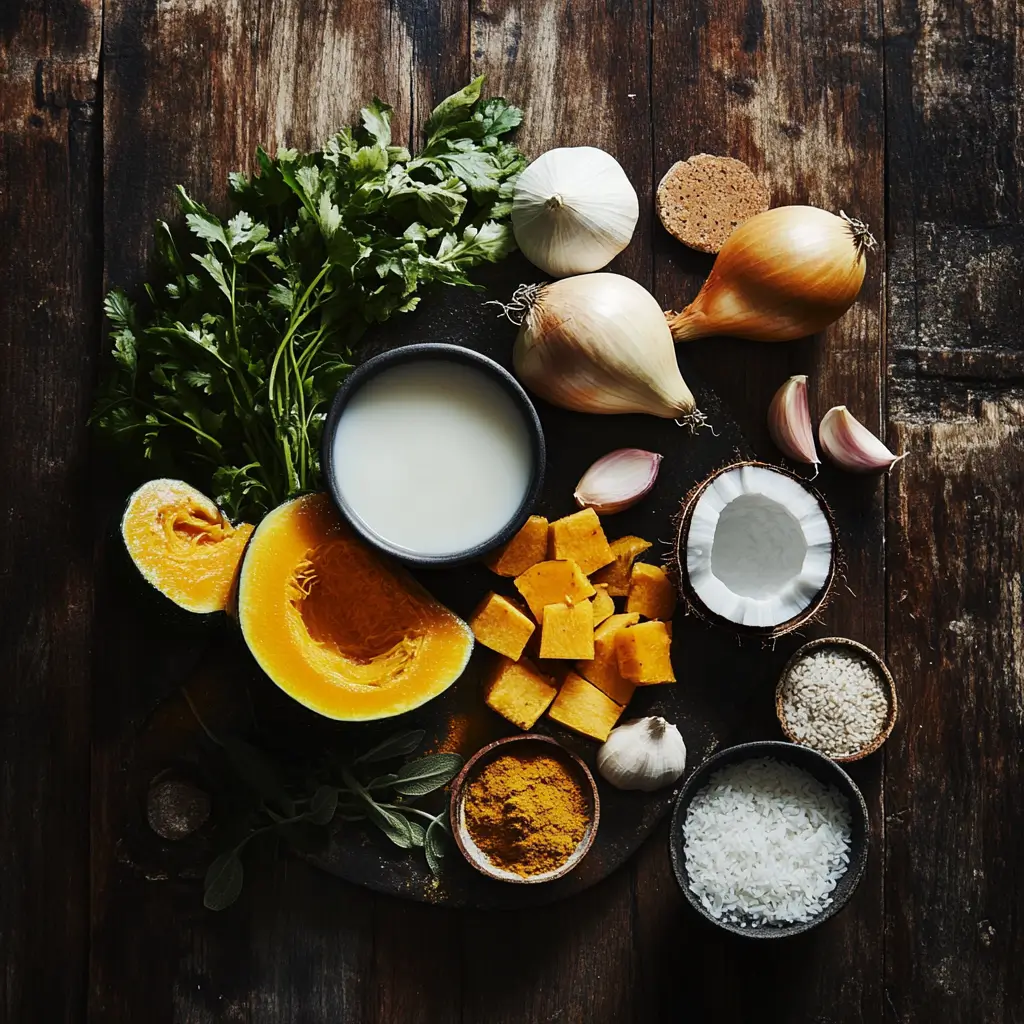When cooler weather rolls in, most of us start craving warm, comforting meals. Roasted Kabocha Squash Soup is one of those timeless dishes that hits the spot every time. As a matter of fact, it combines simplicity, bold flavor, and healthy ingredients in a way that few other soups can. Whether you’re planning a fall dinner party or just looking for a cozy weeknight option, this soup deserves a top spot on your seasonal menu.
As I have said, kabocha squash—also known as Japanese pumpkin—has a rich, nutty taste and a creamy texture when roasted. Unlike butternut or acorn squash, it doesn’t need a lot of embellishment to shine. Additionally, its skin is edible when cooked, making prep easier than you’d expect.
Moreover, we will walk you through every step of creating a luscious soup that feels gourmet but is entirely doable at home. You’ll learn roasting tips, ingredient swaps, seasoning techniques, and even how to customize the soup for special diets. Along the way, I’ll include expert-backed suggestions and firsthand tips that will help you build flavor at every step.
Ingredients and Instructions: Roasted Kabocha Squash Soup
Now that the squash is roasted to perfection, let’s talk ingredients. Overall, this soup uses pantry staples plus a few fresh items. Despite its simplicity, every ingredient plays a key role in delivering full flavor and smooth consistency.

Ingredients Table
| Ingredient | Amount | Notes |
|---|---|---|
| Kabocha squash | 1 medium (2–3 lb) | Skin optional, seeds removed |
| Olive oil | 2 tbsp | For roasting and sautéing |
| Onion | 1 medium | Yellow or white, diced |
| Garlic | 3 cloves | Minced |
| Fresh ginger | 1 inch piece | Optional, grated for a spicy kick |
| Vegetable broth | 4 cups | Use low-sodium for better control |
| Coconut milk | 1 cup | Full-fat preferred for creaminess |
| Salt & pepper | To taste | Season after blending |
| Nutmeg or cinnamon | 1/4 tsp | Optional warming note |
| Fresh thyme or sage | 1 tsp | Garnish and flavor enhancer |
Let’s Make the Soup Step by Step
Even if you’ve never made soup from scratch, this process is easy and rewarding. Firstly, prep your aromatics. Dice the onion, mince the garlic, and grate the ginger if using. The ginger adds subtle heat and freshness, but it’s totally optional.
Secondly, heat a tablespoon of olive oil in a large soup pot. Sauté the onions over medium heat until soft and slightly golden—about 5–6 minutes. Afterward, stir in the garlic and ginger. Cook for 1–2 minutes until the kitchen smells amazing.
Thirdly, add your roasted squash pieces and vegetable broth. Bring everything to a simmer and let it cook gently for about 10 minutes. This helps the flavors blend and makes the squash even softer.
Next, blend the soup. Use an immersion blender straight in the pot or transfer to a high-speed blender in batches. Be careful, as hot liquids expand. In either case, blend until completely smooth.
Once it’s silky, return the soup to low heat. Stir in the coconut milk and any optional spices. Nutmeg or cinnamon works well here, giving the soup a cozy, spiced note. Taste and adjust seasoning with salt and pepper.
Lastly, serve the soup hot, topped with a swirl of coconut milk and a sprinkle of herbs. Optionally, you can garnish with roasted pumpkin seeds or a drizzle of chili oil.

Ingredient Tips and Customization Ideas
Additionally, this soup is easy to customize. For example, if you don’t have coconut milk, try cashew cream or oat milk for a dairy-free alternative. On the other hand, heavy cream adds extra richness if you don’t mind dairy.
You can also tweak the seasonings. If you like bold flavor, try a pinch of curry powder or cumin. For a sweeter take, cinnamon and a splash of maple syrup do wonders. In essence, this soup is a canvas for creativity.
For texture lovers, serve it with crusty bread or top with roasted chickpeas. Meanwhile, if you’re meal-prepping, the soup stores well in the fridge for up to five days. Freeze leftovers in single-serving containers for easy reheating.
In that case, thaw overnight and reheat slowly on the stovetop. Stir occasionally to preserve the creamy consistency. Soup lovers will appreciate how it tastes even better the next day.
As a matter of fact, these small details can elevate your dish from good to unforgettable. Even more, as highlighted in this classic tomato soup recipe, thoughtfully layering flavors and textures transforms simple ingredients into a deeply satisfying bowl.
The Best Way to Roast Kabocha Squash for Soup
Firstly, let’s talk about roasting. This step is what takes Roasted Kabocha Squash Soup from good to unforgettable. Kabocha’s natural sugars caramelize beautifully in the oven, giving it a deep, almost nutty sweetness. Additionally, roasting concentrates the flavor, so you get a richer, more complex soup without needing loads of cream or butter.
To begin with, cut your squash in half and scoop out the seeds. Although the rind looks tough, it’s actually edible and softens with heat. Because of this, many home cooks opt to leave the skin on, especially if they’re blending the soup until smooth. This not only saves time but also adds extra fiber and nutrients.
Next, slice the squash into wedges or thick chunks. After that, toss them with olive oil, sea salt, and cracked pepper. Lay the pieces on a parchment-lined baking sheet. Roast at 400°F for 35–40 minutes, flipping once to ensure even caramelization. During roasting, the edges will brown slightly and the insides will turn fork-tender.
For best results, keep spacing between the pieces. Crowding leads to steaming, not roasting. If needed, use two baking sheets. As illustrated in this creamy Italian sausage soup recipe, roasting ingredients properly enhances depth and richness in a way that boiling simply can’t replicate.
Moreover, this roasting method doesn’t just improve flavor. It also gives you flexibility. You can roast the squash ahead of time and refrigerate it for up to 4 days. In that case, reheat gently or drop it straight into the soup pot when you’re ready to blend.
Why Roasted Squash Beats Boiled Every Time
Most people boil squash out of habit. However, that method strips away flavor and leaves you with a bland, watery base. Conversely, roasting intensifies sweetness and creates those irresistible brown bits that boost the soup’s umami.
In fact, one quick test can prove it. Take a bite of boiled squash and compare it with a piece roasted for 40 minutes. You’ll immediately notice the roasted version is denser, sweeter, and packed with a more robust flavor profile.
For example, roasting kabocha squash allows the flesh to lose excess water, which naturally thickens your soup. Furthermore, it means you can use less cream and still get that velvety texture. Likewise, herbs and spices cling better to roasted chunks, making seasoning more effective overall.
If you’re someone who enjoys layering flavors, roasting gives you that canvas. You can even sprinkle the squash with a little smoked paprika or cinnamon before baking. This tiny step adds character that makes your soup stand out.
Why Kabocha Is the Best Squash for Soup
Unlike other squashes, kabocha has a dense, starchy texture and a naturally sweet taste. Compared to butternut, it’s less watery and more flavorful. Because of that, it holds up better in roasting and results in a creamier soup.
Also, it’s easier to blend. Some squashes, like acorn, remain stringy even after cooking. In contrast, kabocha blends into a velvety texture with minimal effort. Furthermore, its subtle earthiness pairs beautifully with savory or sweet ingredients.
Notably, kabocha is also rich in nutrients. It’s high in beta-carotene, vitamin C, and fiber. So, you’re not only making a comforting meal—you’re also fueling your body with goodness.
How to Master Roasted Kabocha Squash Soup
Once you’ve blended the roasted kabocha squash and aromatics into a rich, velvety base, it’s time to finish the soup with the final touches. After that, return the soup to low heat to keep it warm while incorporating the remaining ingredients.
Firstly, slowly stir in the full-fat coconut milk. This not only adds creaminess but also enhances the natural sweetness of the squash. Additionally, the coconut milk gives the soup a slightly tropical undertone that balances beautifully with savory elements like garlic and onion.
Secondly, taste the soup before adding final seasoning. Although you’ve seasoned earlier during roasting, adjusting at the end ensures a well-balanced flavor. For example, a pinch of cinnamon brings out the squash’s sweet notes, while nutmeg adds depth. If you prefer heat, add a dash of cayenne or chili flakes for contrast.
Furthermore, if the soup is thicker than you’d like, thin it with a bit more vegetable broth or water. Conversely, if it’s too thin, simmer it uncovered for an additional 10–15 minutes, stirring occasionally. This reduces excess liquid and intensifies the flavor.
Additionally, some cooks like to stir in a teaspoon of maple syrup or a dollop of tahini for an earthy-sweet finish. Though optional, these add-ins create a more layered experience in every bite.
Before serving, garnish each bowl with roasted pumpkin seeds, crispy shallots, or a swirl of coconut cream. Not only do these toppings enhance texture, but they also make the dish visually appealing. For an herbaceous finish, top with chopped parsley or fresh thyme leaves.
In that case, serve the soup alongside toasted sourdough, herbed focaccia, or a crisp green salad. Not only does this make it a more complete meal, but it also offers complementary textures that highlight the soup’s creaminess.
Pro Tips & Variations for Roasted Kabocha Squash Soup
Because this soup recipe is so versatile, it adapts easily to personal preferences, seasonal changes, and dietary needs. To begin with, try adding curry powder or Thai red curry paste during the sauté step for a spiced, Southeast Asian variation. As an illustration, this gives the soup a vibrant orange hue and a flavorful kick.
For a more autumnal twist, stir in roasted apple or pear chunks along with the squash. Additionally, root vegetables like carrots or sweet potatoes can deepen the earthy flavor and enhance the soup’s natural sweetness.
Moreover, you can vary the liquids based on your pantry. Although coconut milk is the default, almond milk or oat milk are great alternatives if you prefer a lighter version. On the other hand, using a bit of cream and butter gives the soup a French-inspired richness.
Some home cooks blend in cooked red lentils or cannellini beans to boost protein content. Because they blend smoothly, these ingredients enrich the soup without altering the flavor significantly.
If you’re prepping ahead, store the soup in a sealed container in the fridge for up to five days. Additionally, it freezes well for up to three months. For best results, thaw overnight and reheat gently on the stove while stirring occasionally.
You can also make the soup part of a larger meal. For instance, pair it with a spicy grain bowl or grilled vegetable flatbread. In particular, this makes a comforting yet elegant fall dinner when paired with a chilled white wine.
FAQs About Roasted Kabocha Squash Soup
How long to roast kabocha squash for soup?
Roast the squash at 400°F for 35 to 40 minutes. After flipping halfway through, you’ll see golden edges and a tender inside. Consequently, this method concentrates flavor and ensures a smooth soup texture.
What to do with roasted kabocha squash?
Although soup is the most popular option, roasted kabocha works well in salads, wraps, and bowls. For example, you can mash it with garlic and butter for a cozy side dish or blend it into a creamy pasta sauce. Additionally, cube it and toss into curries or grain salads for extra flavor.
Is kabocha squash good for roasting?
Yes, undeniably. Because of its firm flesh and sweet flavor, kabocha is ideal for roasting. Moreover, it caramelizes beautifully and holds its shape well, which makes it versatile in both savory and sweet dishes.
Do you eat the skin of kabocha squash?
You can eat the skin when it’s roasted. Although it starts out tough, the skin becomes soft and palatable with heat. In blended soups, the skin virtually disappears, especially if blended thoroughly. However, if you want a silky smooth texture, peel it after roasting.
Can I freeze roasted kabocha squash soup?
Yes, freezing works wonderfully. After the soup cools, store it in airtight containers or freezer bags. Label and date them before freezing for up to three months. When ready, thaw overnight in the fridge and reheat gently over medium heat.
What spices pair well with kabocha squash soup?
Nutmeg, cinnamon, turmeric, cumin, and smoked paprika complement the squash’s sweetness. Alternatively, fresh herbs like thyme and sage balance the richness with herbal notes. Experiment based on the direction you want—spicy, sweet, or savory.
Is roasted kabocha squash soup vegan?
Yes, this soup is naturally vegan. It uses vegetable broth and coconut milk, making it perfect for plant-based eaters. Furthermore, you can add vegan-friendly garnishes like roasted seeds, fresh herbs, or plant-based yogurt swirls.
Can I make this in advance?
Absolutely, it’s a great make-ahead dish. Because flavors deepen over time, the soup tastes even better the next day. Store in the fridge for up to five days or freeze in individual portions for quick meals later.
Conclusion
Roasted Kabocha Squash Soup is more than just a seasonal favorite—it’s a nourishing, adaptable, and soul-warming dish that delivers on every level. Whether you’re preparing it for a cozy family dinner or a festive gathering, this soup consistently impresses with its simplicity and depth of flavor.
From carefully roasting the squash to choosing the right garnishes, every step contributes to a bowl that feels comforting yet refined. Additionally, the soup’s flexibility ensures it can be customized to suit any taste or dietary preference.
In summary, this is a recipe you’ll return to all season long. Once you master the technique, you’ll find endless ways to tweak and transform it, making it a permanent favorite in your cold-weather kitchen lineup.
Table of Contents

Roasted Kabocha Squash Soup Recipe for Creamy, Cozy Comfort
- Total Time: 55 minutes
- Yield: About 6 cups of soup
Description
This Roasted Kabocha Squash Soup is cozy, creamy, and deeply flavorful—perfect for fall and winter. Made with pantry staples and fresh aromatics, it’s naturally vegan, rich in nutrients, and irresistibly velvety. Roasting the squash first brings out its natural sweetness, while coconut milk adds luscious creaminess. It’s easy to make, nourishing, and makes a beautiful, comforting bowl of soup.
Ingredients
1 medium Kabocha squash (2–3 lb), seeds removed (skin optional)
2 tbsp olive oil (divided, for roasting and sautéing)
1 medium onion, diced (yellow or white)
3 cloves garlic, minced
1-inch piece fresh ginger, grated (optional, for a spicy kick)
4 cups vegetable broth (low-sodium preferred)
1 cup full-fat coconut milk
Salt and pepper, to taste
1/4 tsp nutmeg or cinnamon (optional, for warmth)
1 tsp fresh thyme or sage (for garnish and added flavor)
Instructions
Prepare the Squash: Preheat oven to 400°F (200°C). Cut the kabocha squash in half, remove seeds, and slice into wedges. Toss with 1 tablespoon olive oil and roast on a baking sheet for 30–40 minutes until fork-tender and slightly caramelized. Let cool slightly, then scoop out the flesh (skin can be used if desired).
Sauté Aromatics: In a large soup pot, heat the remaining tablespoon of olive oil over medium heat. Add diced onion and sauté for 5–6 minutes, until soft and golden. Stir in garlic and ginger (if using) and cook for another 1–2 minutes until fragrant.
Simmer the Soup: Add the roasted squash and vegetable broth to the pot. Bring to a simmer and cook for 10 minutes to meld the flavors.
Blend Until Smooth: Use an immersion blender to puree the soup directly in the pot until silky smooth, or carefully transfer to a blender in batches.
Finish with Coconut Milk: Return soup to low heat. Stir in coconut milk and optional spices like nutmeg or cinnamon. Season to taste with salt and pepper.
Serve: Ladle into bowls and garnish with fresh thyme or sage. Optional toppings: swirl of coconut milk, roasted pumpkin seeds, or a drizzle of chili oil.
Notes
For a lighter version, use light coconut milk or half the amount.
Leftovers store beautifully—keep in the fridge for up to 4 days or freeze for later.
Add a touch of maple syrup for extra sweetness if desired.
This soup pairs well with crusty bread or a fresh green salad.
- Prep Time: 15 minutes
- Cook Time: 40 minutes
- Category: Dinner
- Cuisine: American
Nutrition
- Calories: 230
- Fat: 14g
- Carbohydrates: 22g
- Protein: 3g
